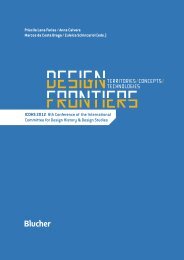Urban Climate News - FAU
Urban Climate News - FAU
Urban Climate News - FAU
Create successful ePaper yourself
Turn your PDF publications into a flip-book with our unique Google optimized e-Paper software.
Special Report<br />
Announcing the Student Award Winners from the th International<br />
Conference on <strong>Urban</strong> <strong>Climate</strong> (ICUC ) in Dublin<br />
The IAUC has announced the names of 13 student<br />
award winners who were recognized for work they presented<br />
in August 2012 at the Eighth International Conference<br />
on <strong>Urban</strong> <strong>Climate</strong> (ICUC ) in Dublin, Ireland.<br />
Each of these PhD students has been awarded a $200<br />
prize, with funding coming from the Board of the <strong>Urban</strong><br />
Environment of the American Meteorological Society,<br />
the WMO, the EPA and SFI in Ireland, and the family of<br />
William P. Lowry, who was an important contributor to<br />
the field of urban climatology.<br />
This edition of <strong>Urban</strong> <strong>Climate</strong> <strong>News</strong> includes articles by<br />
recipients of the IAUC and Lowry awards (see pages 7-<br />
34), and the work of AMS award winners will appear in<br />
the March2013 issue.<br />
Jonas Alegrini<br />
Empa Dübendorf,<br />
Switzerland<br />
AMS Student Award<br />
The urban microclimate has a significant influence<br />
on the energy demand for space cooling and heating in<br />
buildings. The radiative heat gains are increased due to<br />
multiple reflections of longwave and solar radiation between<br />
the buildings. The convective heat transfer at the<br />
building façades is decreased, because the wind speeds<br />
are decreased in urban areas. Further, the air temperatures<br />
are, due to the urban heat island effect, increased<br />
in urban compared to rural areas. All three effects lead<br />
to a higher space cooling demand for buildings in urban<br />
areas. This study shows the importance of accounting<br />
for the local urban microclimate, when predicting the<br />
energy demands for buildings in urban areas.<br />
Ifeoluwa Adebowale Balogun<br />
Federal University Of Technology,<br />
Akure, Nigeria<br />
Lowry Student Award for Africa<br />
I am a lecturer at the Department of Meteorology,<br />
School of Earth and Mineral Sciences, Federal University<br />
of Technology, Akure, Nigeria. I am an applied meteorologist<br />
with expertise in micrometeorology, urban climate,<br />
ISSUE NO. 46 DECEMBER 2012 INTERNATIONAL ASSOCIATION FOR URBAN CLIMATE<br />
35<br />
biometeorology, and climate change. I have specific interest<br />
in monitoring, assessing and quantifying urban<br />
impacts and associated landuse landcover changes on<br />
local climate, air quality and inhabitants’ comfort. I have<br />
participated in several micrometeorology and urban climate<br />
field experiments in Nigeria. My current research<br />
involves understanding the role of cities in modifying<br />
the weather, climate and air quality, and also suggesting<br />
how such research may be usefully employed at various<br />
scales of urban management by architects, environmentalists,<br />
urban planners, and decision and policy makers.<br />
The research also involves mitigation measures that can<br />
be applied to combat climate change impacts.<br />
I have authored or co-authored several publications<br />
on these issues in reputable journals. Several more manuscripts<br />
are currently in preparation.<br />
Research Summary - <strong>Urban</strong>isation with its attendant<br />
landuse and landcover changes (LULCC) has been affirmed<br />
to produce significant changes in surface and atmospheric<br />
properties that can result in inadvertent local<br />
weather and climate changes. In view of this, Akure (Lat:<br />
7.25 °N; Lon: 5.20 °E), a medium sized rapidly developing<br />
tropical city in south-western Nigeria, has been investigated.<br />
Incidentally, the city ranks among the Millennium<br />
Cities initiative project of the Columbia University and<br />
Columbia national investment working with the Millennium<br />
Developmental Goals (MDG) support team of the<br />
United Nations Development Program (UNDP). A network<br />
of in situ measuring stations were set up for two<br />
years (January, 2009 - December, 2010) at seventeen different<br />
locations within the city with each landuse type<br />
fairly represented.<br />
Understanding the extent of change in the transition<br />
of various land use types within the city metropolis is<br />
very important. Multi-temporal remote sensing data and<br />
GIS techniques were used to detect landuse landcover<br />
changes and analyse the urban expansion through different<br />
classification schemes, and the associated climatic<br />
responses were further investigated. Results shows<br />
the consequential modifications of the city growth on<br />
the local climate as the relationship between the urban<br />
and rural parameters indicates the significance of local<br />
effects. <strong>Urban</strong>ization effects on local temperature and<br />
humidity have been shown to be significant in the city.<br />
Values of cooling degree days obtained to estimate<br />
how much cooling energy may be needed for inhabitants’<br />
comfort revealed that elevated temperatures in the<br />
central urban areas at both day and night will increase<br />
the potential for cooling of buildings. Existing bioclimat-
















